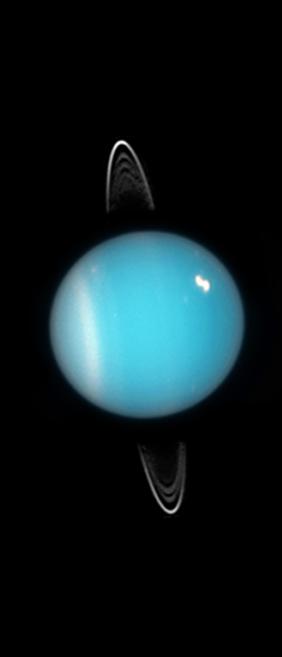Glossarbegriffe: Planetenring
Description: Die vier Riesenplaneten unseres Sonnensystems (Jupiter, Saturn, Uranus und Neptun) sind von zahlreichen mikrometer- bis metergroßen Eis- oder Gesteinsbrocken umgeben, die ringförmig um den jeweiligen Planeten verteilt sind.
Am spektakulärsten sind die Ringe des Saturn: Der Saturn ist von mehreren Ringen umgeben, die durch Lücken voneinander getrennt sind. Ein Teil dieser Struktur der Saturnringe entsteht durch die Wechselwirkung mit den größeren Monden des Saturns. Winzige Monde haben zwei Lücken geöffnet und umkreisen den Saturn in diesen Lücken. Es gibt mehrere Hypothesen darüber, wie die Ringe entstanden sind. Die meisten davon gehen davon aus, dass die Schwerkraft des Saturn einen Mond zerrissen hat. Einigen Schätzungen zufolge werden sich die Saturnringe in einigen 100 Millionen Jahren aufgelöst haben. Das ist nach astronomischen Maßstäben keine sehr lange Zeit. Jupiter, Uranus und Neptun haben weniger ausgeprägte Ringsysteme.
Bei Exoplaneten wurden bislang noch keine Planetenringe nachgewiesen.
Zugehörige Glossarbegriffe:
See this term in other languages
Term and definition status: The original definition of this term in English have been approved by a research astronomer and a teacher The translation of this term and its definition is still awaiting approval
The OAE Multilingual Glossary is a project of the IAU Office of Astronomy for Education (OAE) in collaboration with the IAU Office of Astronomy Outreach (OAO). The terms and definitions were chosen, written and reviewed by a collective effort from the OAE, the OAE Centers and Nodes, the OAE National Astronomy Education Coordinators (NAECs) and other volunteers. You can find a full list of credits here. All glossary terms and their definitions are released under a Creative Commons CC BY-4.0 license and should be credited to "IAU OAE".
If you notice a factual or translation error in this glossary term or definition then please get in touch.
Zugehörige Medien
Saturn
Bildnachweis: NASA, ESA, A. Simon (Goddard Space Flight Center), and M.H. Wong (University of California, Berkeley) credit link
License: CC-BY-4.0 Creative Commons Namensnennung 4.0 International (CC BY 4.0) icons
Uranus with rings
Bildnachweis: NASA, ESA, and M. Showalter (SETI Institute) credit link
License: PD Public Domain icons










